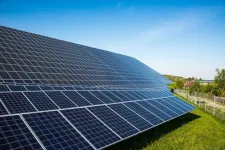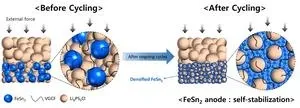Towards better solar cells: Exploring an anomalous phenomenon of electricity generation
Researchers explore the bulk photovoltaic effect in a promising material for next-generation solar harvesting technologies
2024-10-22
(Press-News.org)
The bulk photovoltaic (BPV) effect is an uncommon phenomenon that may enable certain materials to outperform the conventional p–n junctions used in solar cells. In a recent study, researchers from Japan have experimentally demonstrated the BPV effect in alpha-phase indium selenide (α-In2Se3) for the first time along the out-of-plane direction, validating previous theoretical predictions. The remarkable conversion efficiency recorded in their α-In2Se3 device signals a promising advancement for future solar cell technologies and photosensors.
A firm understanding of the photovoltaic effect, by which light can be converted into useful electrical energy, lies at the core of solar cell design and development. Today, most solar cells employ p–n junctions, leveraging the photovoltaic effect that occurs at the interface of different materials. However, such designs are constrained by the Shockley–Queisser limit, which puts a hard cap on their theoretical maximum solar conversion efficiency and imposes a tradeoff between the voltage and current that can be produced via the photovoltaic effect.
However, certain crystalline materials exhibit an intriguing phenomenon known as the bulk photovoltaic (BPV) effect. In materials lacking internal symmetry, electrons excited by light can move coherently in a specific direction instead of returning to their original positions. This results in what is known as “shift currents,” leading to the generation of the BPV effect. Although experts have predicted alpha-phase indium selenide (α-In2Se3) to be a possible candidate to demonstrate this phenomenon, it hasn’t yet been experimentally investigated.
To fill this knowledge gap, a research team from Japan led by Associate Professor Noriyuki Urakami from Shinshu University set out to explore the BPV effect in α-In2Se3. Their findings were published in Volume 125, Issue 7 of Applied Physics Letters on August 12, 2024 and made available online on August 14, 2024.
“This material has recently become a hot topic in the field of condensed matter physics, as it might be able to generate a shift current. Our study is the first to experimentally demonstrate this prediction,” shares Prof. Urakami.
First, the researchers produced a layered device composed of a thin α-In2Se3 layer sandwiched between two transparent graphite layers. These graphite layers served as electrodes and were connected to a voltage source and an ammeter to measure any generated currents upon light irradiation. Notably, the team employed this specific arrangement of layers because they focused on the shift currents occurring in the out-of-plane direction in the α-In2Se3 layer.
After testing with different external voltages and incident light of various frequencies, the researchers verified the existence of shift currents in the out-of-plane direction, confirming the abovementioned predictions. The BPV effect occurred throughout a wide range of light frequencies.
Most importantly, the researchers gauged the potential of the BPV effect in α-In2Se3 and compared it to that in other materials. “Our α-In2Se3 device demonstrated a quantum efficiency several orders of magnitude higher than other ferroelectric materials, and a comparable one to that of low-dimensional materials with enhanced electric polarization,” remarks Prof. Urakami. He further adds, “This discovery will guide material selection for the development of functional photovoltaic devices in the near future.”
The research team is hopeful that their efforts will eventually have a positive environmental impact by contributing to the field of renewable energy generation. “Our findings have the potential to further accelerate the spread of solar cells, one of the key technologies for environmental energy harvesting and a promising avenue towards a carbon neutral society,” concludes a hopeful Prof. Urakami.
We hope that this study paves the way for further studies to harness the BVP effect and vastly improve the performance of solar cells, as well as enhance the design of sensitive photodetectors.
###
About Shinshu University
Shinshu University is a national university founded in 1949 and located nestling under the Japanese Alps in Nagano known for its stunning natural landscapes. Our motto, "Powered by Nature - strengthening our network with society and applying nature to create innovative solutions for a better tomorrow" reflects the mission of fostering promising creative professionals and deepening the collaborative relationship with local communities, which leads to our contribution to regional development by innovation in various fields. We’re working on providing solutions for building a sustainable society through interdisciplinary research fields: material science (carbon, fiber and composites), biomedical science (for intractable diseases and preventive medicine) and mountain science, and aiming to boost research and innovation capability through collaborative projects with distinguished researchers from the world. For more information visit https://www.shinshu-u.ac.jp/english/ or follow us on X (Twitter) @ShinshuUni for our latest news.
END
ELSE PRESS RELEASES FROM THIS DATE:
2024-10-22
The KERI's research on anode materials for solid-state batteries (SSBs), conducted in collaboration with Kumoh National Institute of Technology and Inha University, has been selected as the cover article of a world-leading journal in the energy field.
The SSBs have replaced the combustible liquid electrolyte that transfers ions between the anode and cathode with a solid electrolyte, significantly reducing the risk of fire or explosion. However, SSBs, due to their 'solid' nature, require much advanced technology, such as ensuring electro-chemo-mechanical stability during the charging and discharging processes. In particular, since the anode has a ...
2024-10-22
A Visit from the Stork Brings Genomic Hope for this Endangered Species
A new genomic study of the endangered Oriental Stork reveals that the population's genetic health is still surprisingly strong, with high genetic diversity and low levels of inbreeding. This is an uncommon finding in most endangered species populations, which makes it more difficult to rescue those species from extinction. Thus, despite the human-caused decline in the Oriental stork numbers, the findings in this study provide hope for the species' long-term ...
2024-10-21
Peer reviewed | Observational study | People
Rapid urbanisation and population growth in sub-Saharan Africa has increased the incidence of asthma in young people, but the lack of diagnosis and care means that many young people are suffering from untreated symptoms of asthma, according to research from Queen Mary University of London.
The team who led the study, whose pioneering research on the impact of pollution on lung health was instrumental in introducing the Ultra Low-Emission Zone (ULEZ) in London, are calling for better access to asthma diagnosis and care in areas of ...
2024-10-21
OCTOBER 21, 2024, NEW YORK – Ludwig Cancer Research scientists have devised new types of chimeric antigen-receptor (CAR) T cells—a type of cancer immunotherapy—that can be switched on to varying degrees of intensity and then switched off on demand with existing drugs. The design and preclinical evaluation of the CAR-T cells, led by Melita Irving and Greta Maria Paola Giordano Attianese of the Lausanne Branch of the Ludwig Institute for Cancer Research, is detailed in this week’s issue of the Proceedings of the National Academy of Sciences.
“CAR-T cells are already used today to treat a number of blood cancers, but ...
2024-10-21
CORVALLIS, Ore. – A changing climate triggers a sudden shift in ocean circulation, creating weather havoc and plunging Earth into an abrupt new Ice Age.
It sounds like the basis for a Hollywood blockbuster - the 2004 science fiction disaster film “The Day After Tomorrow,” has similar plot lines – but it’s actually a scenario that played out multiple times during the last Ice Age, which ended more than 11,000 years ago.
Just published research from multiple ice cores collected across Greenland with data spanning up to 120,000 years provides new understanding of these abrupt events, how they unfold and what that might ...
2024-10-21
The extent to which “civilization” heightens or lessens the likelihood of violent conflict throughout human history has remained one of the most enduring questions among anthropologists. But a new collaborative study of archaeological groups from the Andes region of South America suggests that being part of a centrally organized state society is only part of the equation.
“Our findings suggest that being in a ‘civilization’ may reduce violence, but only for women, and only slightly then,” ...
2024-10-21
SAN FRANCISCO—Neuroscientist Rusty Gage, PhD, will be the recipient of the 2024 Ogawa-Yamanaka Stem Cell Prize, awarded by Gladstone Institutes. He was selected for pioneering stem cell biology of the central nervous system and the use of reprogrammed cells to study age-related neurodegenerative disease and psychiatric disorders.
Gage is a professor in the Laboratory of Genetics at the Salk Institute for Biological Studies, where he also serves as the Vi and John Adler Chair for Research on Age-Related Neurodegenerative Disease. He was president of the Salk Institute from 2018 to 2023.
Over the course of his scientific career, Gage has made several paradigm-shifting ...
2024-10-21
Researchers in the Stanford Radio Glaciology lab use radio waves to understand rapidly changing ice sheets and their contributions to global sea-level rise. This technique has revealed groundwater beneath Greenland, the long-term impacts of extreme melt, a process that could accelerate ice sheet mass loss in Antarctica, the potential instability of an ice sheet that could raise sea levels by 10 feet, and more.
Now, PhD students within the group have created an open-source tool that others can use to make ice-penetrating radar systems, core instruments ...
2024-10-21
Stories written by the latest version of ChatGPT were nearly as good as those written by human authors, according to new research on the narrative skills of artificial intelligence.
But when people were told a story was written by AI — whether the true author was an algorithm or a person — they rated the story poorly, a sign that people distrust and dislike AI-generated art.
“People don’t like when they think a story is written by AI, whether it was or not,” said Haoran “Chris” Chu, Ph.D., a professor of public relations at the University of Florida and co-author of the new study. “AI is good at writing something that is consistent, ...
2024-10-21
HOUSTON, Oct. 21, 2024 – The University of Houston and Scotland’s Heriot-Watt University have awarded seed grants to six innovative energy projects as part of their transatlantic research collaboration. The projects, which bring together researchers from both universities, focus on cutting-edge solutions ranging from advanced hydrogen sensing technology to converting waste into sustainable products.
“This partnership is rooted in a shared commitment to advancing research that supports a just energy ...
LAST 30 PRESS RELEASES:
[Press-News.org] Towards better solar cells: Exploring an anomalous phenomenon of electricity generation
Researchers explore the bulk photovoltaic effect in a promising material for next-generation solar harvesting technologies







